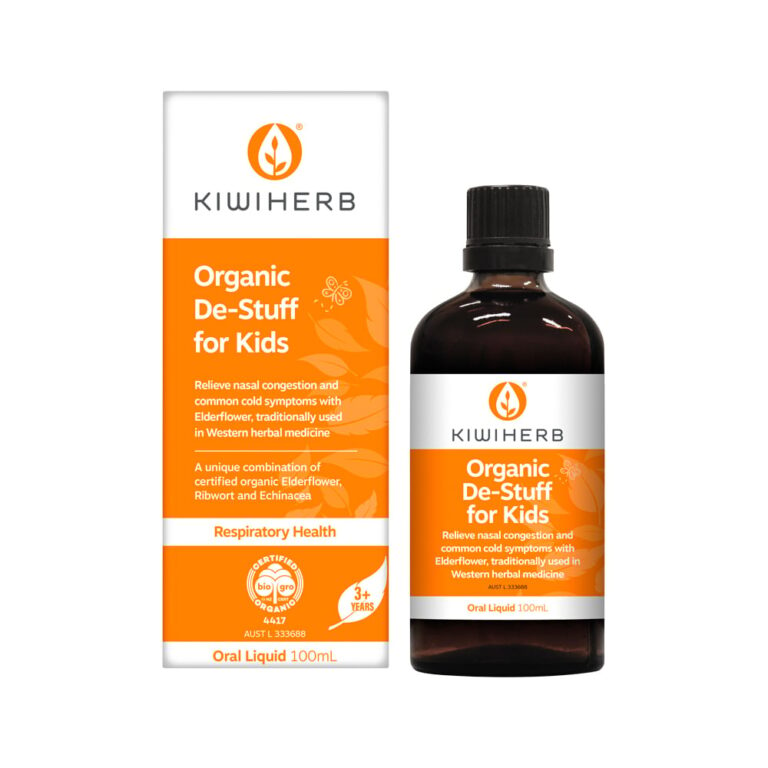Kiwiherb Herbal Throat Spray
Herbal Throat Spray is a fresh tasting, convenient solution for oral health. A unique formulation containing New Zealand native Kawakawa (Macropiper excelsum) ‐ renowned for it’s fresh peppery taste and with a long history of use in traditional Maori medicine. Also contains certified organic Thyme, Echinacea root and Propolis in a base of Manuka Honey.
Natural refreshing taste
Convenient spray
Freshens the mouth
May help eliminate the bacteria that can cause bad breath
Certified Organic ingredients
$42.20
Certified Organic
| Certification |
|---|
Product information
| Brand | |
|---|---|
| Certificate | |
| Volume | |
| Product Attributes | , , , |
Ingredients
Four sprays (0.4mL) contains:
Macropiper excelsum var excelsum (Kawakawa) dry leaf extract
derived from 28mg dry leaf
56 microlitres
Echinacea purpurea (Echinacea) dry root extract
derived from 24mg dry root
48 microlitres
Thymus vulgaris (Thyme) dry herb extract
derived from 20mg dry herb
40 microlitres
Honey
28mg
Propolis tincture
9 microlitres
Peppermint oil
0.8 microlitres
Leptospermum scoparium (M?nuka) oil
0.4 microlitres
In a base of purified water and ethanol.
Contains no artificial flavours, sweeteners, colours, or preservatives.
Directions for use
Adults & Children: 2 to 4 sprays.
Spray directly into the mouth every 1-2 hours.
Warnings
Always read the label. Use only as directed. If symptoms persist consult your health professional.
Not recommended for those allergic to propolis or bee products. Those allergic to Asteraceae family plants (e.g. chamomile, artichokes, daisies) should take care when taking Echinacea due to possible allergic reaction.
Temporary harmless tingling in the mouth may occur immediately after taking as a natural effect of high quality Echinacea this is normal and indicative of the quality & potency of Echinacea.
Highly flammable. Keep away from sources of ignition- no smoking. Keep container tightly closed.
Customer Reviews
Online Sports Nutrition and Natural Dietetics.
Chances are there wasn't collaboration, communication, and checkpoints, there wasn't a process agreed upon or specified with the granularity required. It's content strategy gone awry right from the start. Forswearing the use of Lorem Ipsum wouldn't have helped, won't help now. It's like saying you're a bad designer, use less bold text, don't use italics in every other paragraph. True enough, but that's not all that it takes to get things back on track.
The villagers are out there with a vengeance to get that Frankenstein
You made all the required mock ups for commissioned layout, got all the approvals, built a tested code base or had them built, you decided on a content management system, got a license for it or adapted:
- The toppings you may chose for that TV dinner pizza slice when you forgot to shop for foods, the paint you may slap on your face to impress the new boss is your business.
- But what about your daily bread? Design comps, layouts, wireframes—will your clients accept that you go about things the facile way?
- Authorities in our business will tell in no uncertain terms that Lorem Ipsum is that huge, huge no no to forswear forever.
- Not so fast, I'd say, there are some redeeming factors in favor of greeking text, as its use is merely the symptom of a worse problem to take into consideration.
- Websites in professional use templating systems.
- Commercial publishing platforms and content management systems ensure that you can show different text, different data using the same template.
- When it's about controlling hundreds of articles, product pages for web shops, or user profiles in social networks, all of them potentially with different sizes, formats, rules for differing elements things can break, designs agreed upon can have unintended consequences and look much different than expected.
This is quite a problem to solve, but just doing without greeking text won't fix it. Using test items of real content and data in designs will help, but there's no guarantee that every oddity will be found and corrected. Do you want to be sure? Then a prototype or beta site with real content published from the real CMS is needed—but you’re not going that far until you go through an initial design cycle.


